Africa evokes images of safaris and tents, of bush dinners and camping, of sunny desserts and grassy oases. Every country on the African continent has a telling history and rich diversity. But there’s more! The food in Africa is as diverse as her people, ranging from the spicy and flavorful to refreshing and unique. Want to know what to eat in Africa? What is the most popular food in Africa? And what are the most common African dishes? Here are some of the most popular must-try foods to eat in Africa and her nations when you visit this remarkable continent.
1. Briks in Tunisia
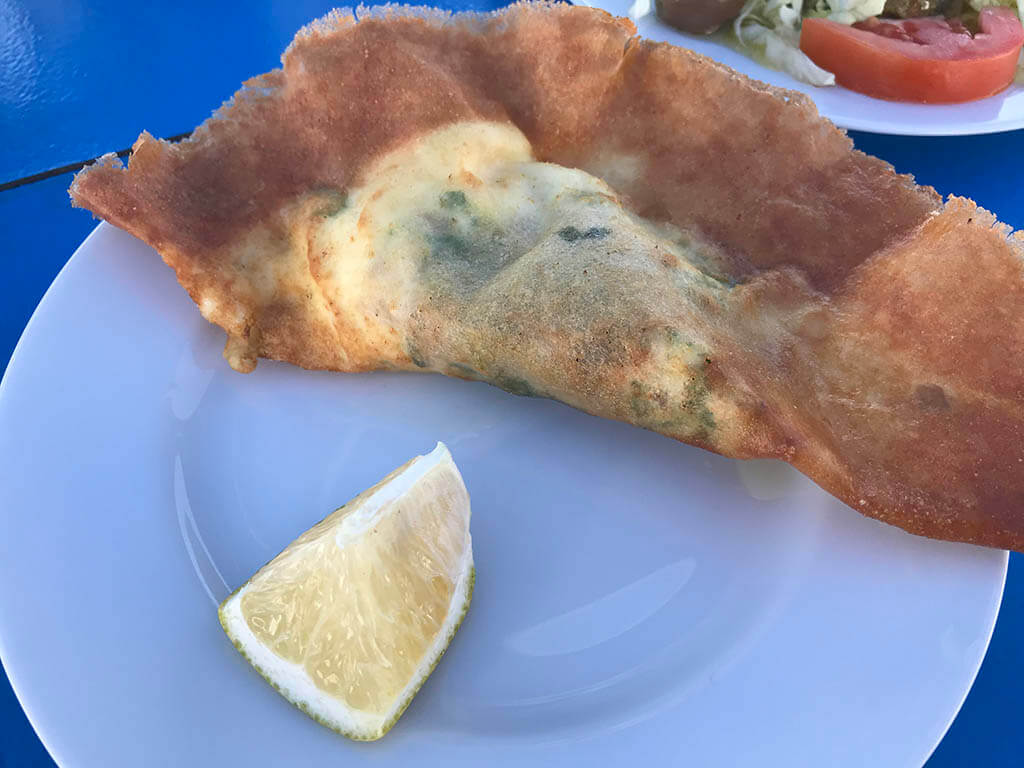
Pic by Leyla from Women on the Road
There’s no more typical Tunisian dish these days than ‘brik’, a paper-thin pastry shaped into a half moon and filled with tuna, cheese and an egg – but it wasn’t always Tunisian, not exactly. The brik’s origins are somewhat controversial and several countries claim its parentage. In one version, the brik earned its stripes in Central Asia under the Ottomans and belongs to the same family as the Turkish börek. In another, it is native to the North African Maghreb, a favorite of Berber nomads who needed food that was simple to make and easy to carry. It then spread throughout the region.
Whatever its origins, it is now a traditional food during Ramadan, the month of Muslim fast.
You’ll find brik almost everywhere, in restaurants, markets and as street food – the perfect little snack. Briks are deep fried and eaten with your fingers, with a squirt of lemon over the pastry. It’s also quite difficult to stop at one…
By Leyla from Women on the Road
Find out more about Travel in Tunisia here! Or catch up with Women on the Road on Facebook here!
2. Thieboudienne in Senegal
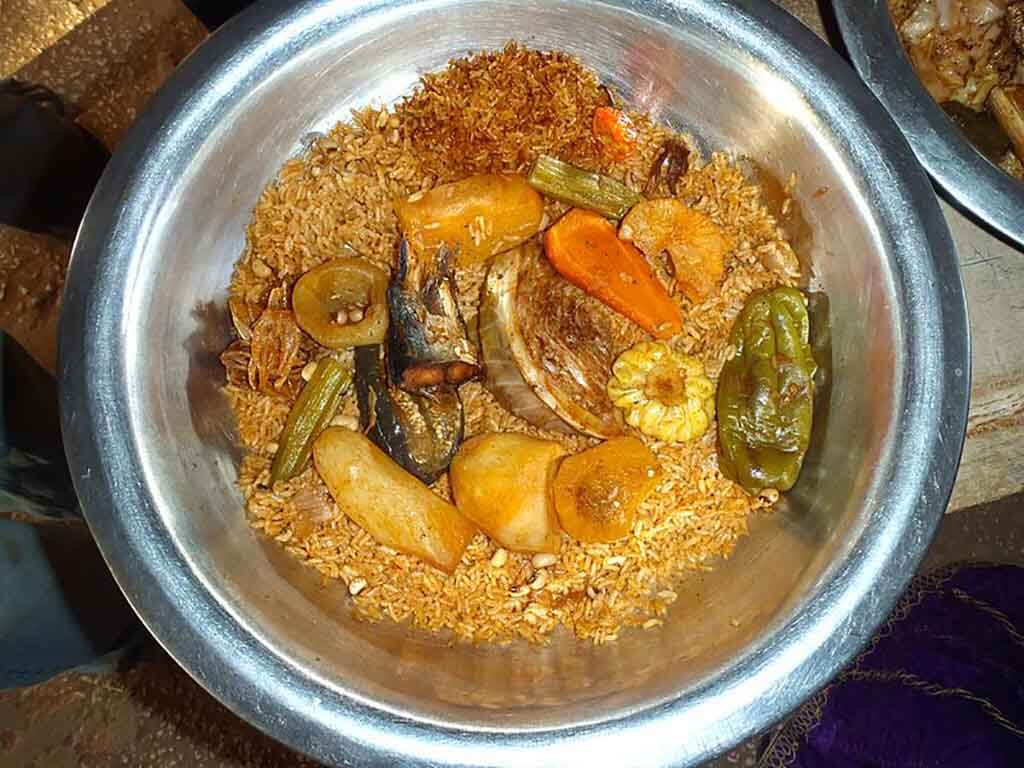
Pic by Mariel.cg from Wiki Commons CC BY-SA 4.0
When you visit Senegal, you cannot leave the country without having tried their most popular dish: the thieboudienne.
Its name comes from Wolof, the local language of the indigenous people, and it means Fish Rice. Needless to say, the main ingredients are indeed rice, always present in African dishes, and fish, a great source of food in Senegal thanks to the long coastline. Other important ingredients to complete a real Thieboudienne are tomato sauce, lemon, stock and some vegetables.
It seems that it was historically invented in Saint-Louis, the ancient capital of Senegal, during the 19th century. In modern times it is severed on a big tray, usually made of metal, with the rice at the bottom, with all the rest placed on top.
It is a traditional dish that is eaten during communal celebrations. All commensals sit around the table and eat with their hands from the tray.
While the main recipe is with fish, there are also two variations of the thieboudienne. If you replace fish with meat, you will be eating a tiep yappa, while if chicken is the main ingredient, then it becomes a tiep ganaar.
Whichever you choose to try in Senegal, you will not regret it!
By Mario from Rest & Recuperation
Catch up with Rest & Recuperation on Facebook here!
3. Tajine in Morocco
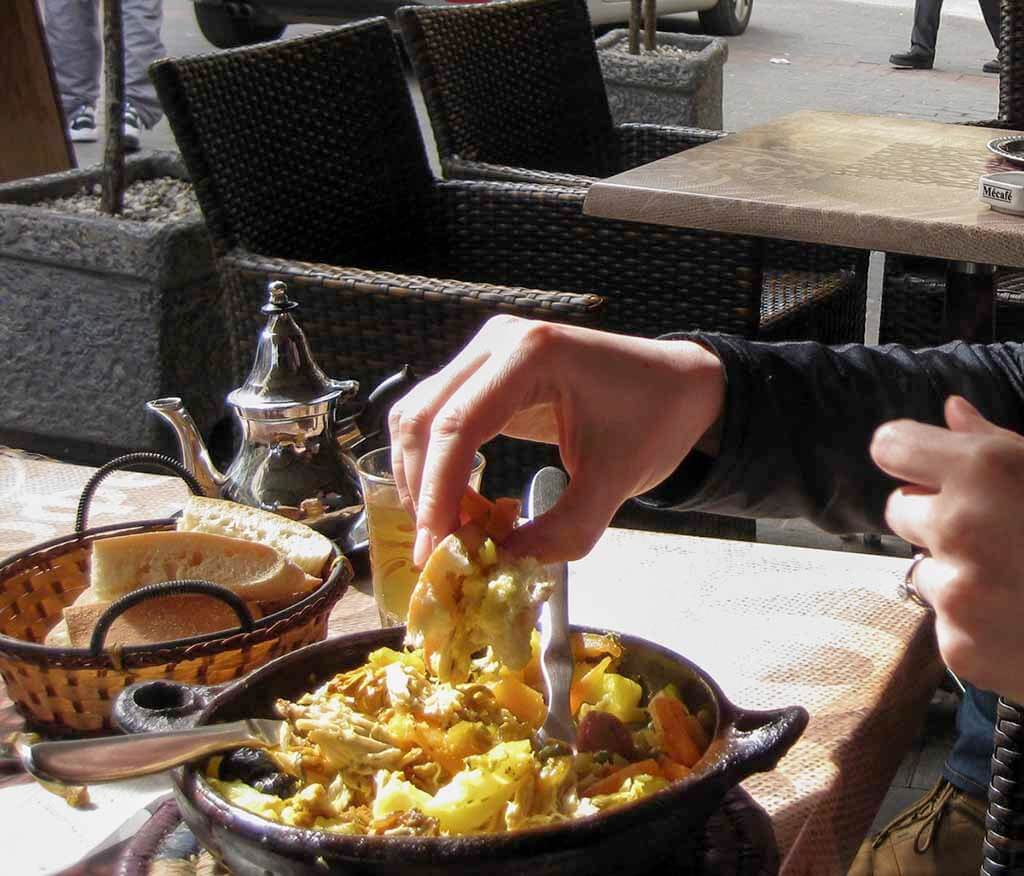
Pic by Dariece from Goats On The Road
Couscous might be the national dish of Morocco, but tajine is one of the most popular. The word tajine actually means the dish that the meal is cooked in, which is an earthenware clay pot with a shallow bowl as the base and a cone-shaped lid.
The earliest writings of tajine cooking are from the 9th century; and although it’s debatable who created the tajine style of cooking, many say it was Berber nomads in the north of Africa who would stew tougher meat in these pots over an open fire.
Some classic tajine ingredients include duck with honey and dates, lamb with dried prunes, or fish with lime and tomatoes.
Tajines are a unique vessel for cooking, as the cone traps in the steam, releasing the moisture back into the food. No tajine is dry and bland, and no matter which combination you decide to try in Morocco, you won’t be disappointed.
I had my first Moroccan tajine dish back in 2011 when travelling around the country. At first, I had no idea what it was — I’d only been travelling in Asia in the past, so these smells, flavours, and style of cooking were all new to me.
Tangier, which was my first stop on my Moroccan trip, was the city I chose to sample a chicken tajine. At the table arrived a piping hot earthenware pot. The cone was lifted by the waiter and hitting my nose were sour and salty notes — from the dried, preserved lemons and green olives of the region.
The chicken was stewed to perfection, and the combination of flavours was something I’d never experienced before. This quickly became my go-to meal in Morocco and landed itself on my list of the best foods in the world.
By Dariece from Goats On The Road
Catch up with Goats On The Road on Facebook here!
4. Ugali Fries in Kenya
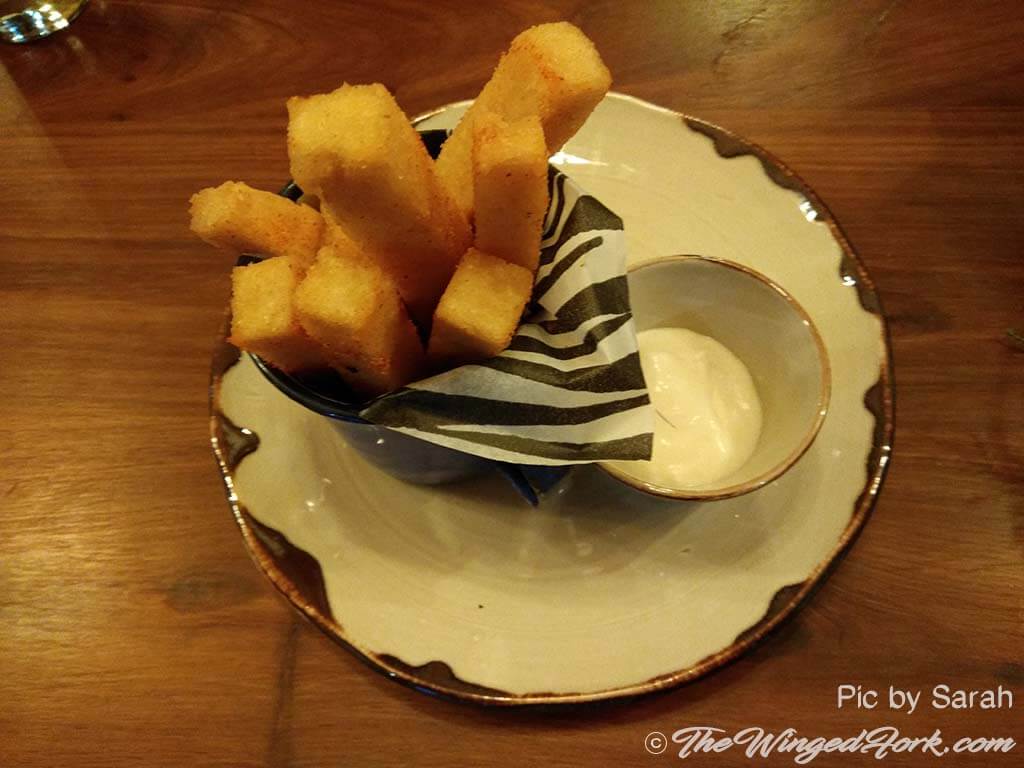
Pic by Sarah, writer at Abby’s Hearth
Ugali is a type of maize flour porridge made in Africa. Having been to Kenya a couple of times, I have had the chance to try this local dish at a few different lodges and while dining with friends. It is a staple food in the diet of the Kenyan people, and served with almost every meal, just like rice or potatoes in other countries. Ugali can be accompanied by veggies, chicken or meat.
The ugali is cooked by boiling the maize flour in water or milk till it becomes almost dough-like. If maize is unavailable, millet, sorghum or cassava are sometimes used. I found the ugali to be somewhat similar to the Indian Apam or Sanna or Idli that are made from rice and other flours.
You eat ugali by making a small ball of it with your fingers, then making a depression in it with your thumb and using that to scoop up your meats and vegetables.
It’s believed that before the 19th century, sorghum and millet were staple grains in Kenya. So how did Ugali come to Kenya? The Portuguese traders brought maize aka corn to Kenya in the 19th century and grew it as an export crop. The locals found it similar to sorghum and adapted it into their cooking, creating this popular African food dish called Ugali.
I am not a very big fan of Ugali, as I found it quite heavy and filling. But there is one version of it that I absolutely love, and that is the Ugali fries. This crispy treat is quite tasty and can be had as a snack, not just as a meal.
By Sarah from TheWingedFork
Find out about here! Join the AbbysPlate and TheWingedFork group on Facebook here!
5. Zaalouk in Morocco
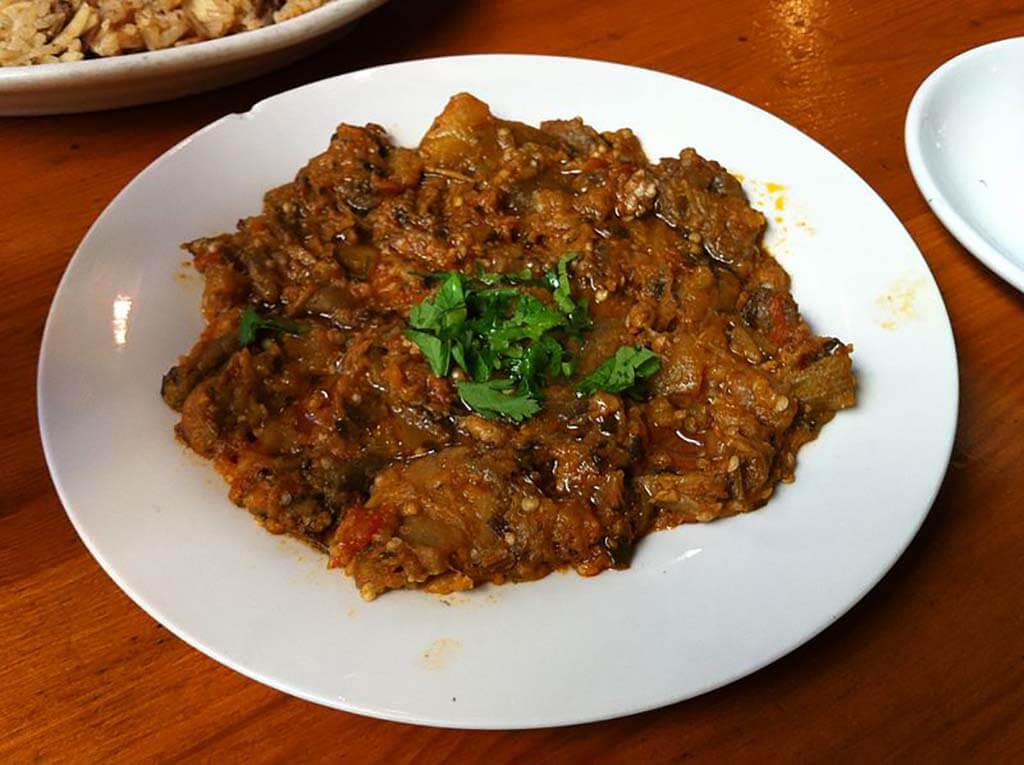
Pic by Tamorlan from Wiki CC by SA 3.0
Zaalouk is an amazing salad dish that hails from Morocco. This aromatic Moroccan salad is made with eggplant (or aubergine), tomatoes, garlic, plenty of olive oil and spices including cumin, paprika, salt, and coriander.
During our stay in Morocco, we were served Zaalouk as a small side dish in accompaniment with our reliably provided bread and tajine, but we easily could have had it as our main course. It was that delicious.
While it’s history is relatively unknown, Zaalouk varies in ingredients and preparation depending on the region. While the spice amount undoubtedly makes a difference, it’s how the eggplant is cooked that alters the taste of Zaalouk the most. We’ve been told you can grill it, fry it, boil it or smoke it. Whichever way is chosen, the eggplant is then mixed in with the tomatoes, spices, and oil to produce an incredibly mouth-watering dish that bears a flavor similar to chili or ratatouille.
When in Morocco, we highly recommend trying Zaalouk more than once so you can experience the different taste varieties of this delicious Moroccon salad. Our favorite Zaaolouk was at the YA HALA restaurant in Meknes, if you happen to make a trip to this imperial city.
By Ashley from Impact Winder
Catch up with Ashley on Instagram here!
6. Injera in Ethiopia
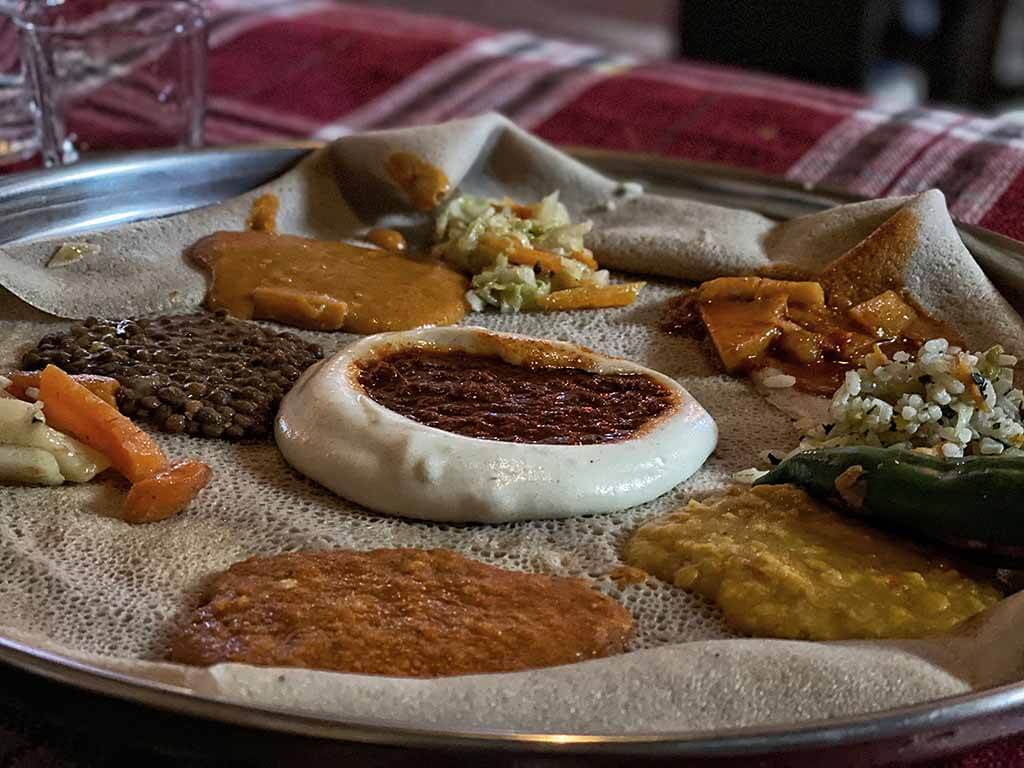
Pic by Claudia from My Adventures Across The World
One of the perks of traveling to Ethiopia is trying local food. It really has a unique flavor which you will hardly encounter anywhere else. The most common food is injera.
Injera is ever present on the tables of Ethiopia. This spongy sour bread is made with teff flour, which is highly nutritious, and it is therefore considered a superfood. The typical meal in Ethiopia sees a massive tray placed at the center of the table and shared among various guests. Injera is laid on the tray, with a variety of toppings on it. You won’t be handed forks or spoons but are expected to scoop the food up with a piece of injera.
One of the best toppings is shiro tegamino, a very thick stew prepared with powdered chickpeas with onion, garlic, ground ginger, tomatoes and chili peppers. It can be more or less spicy, and it definitely is very greasy.
Another topping can be injera firfir, which literally is chopped injera with clarified butter and spices.
These are all vegan dishes – as a lot of other traditional dishes in Ethiopia. Many locals are Christian Copts who follow the requirements of their religion even when it comes to their diet, and regularly fast – which to them means avoiding any animal products, including dairy and eggs. Vegan food is commonly referred to as “fasting food.”
By Claudia from My Adventures Across The World
Catch up with My Adventures Across The World on Facebook here!
7. Puff – Puff in Central Africa
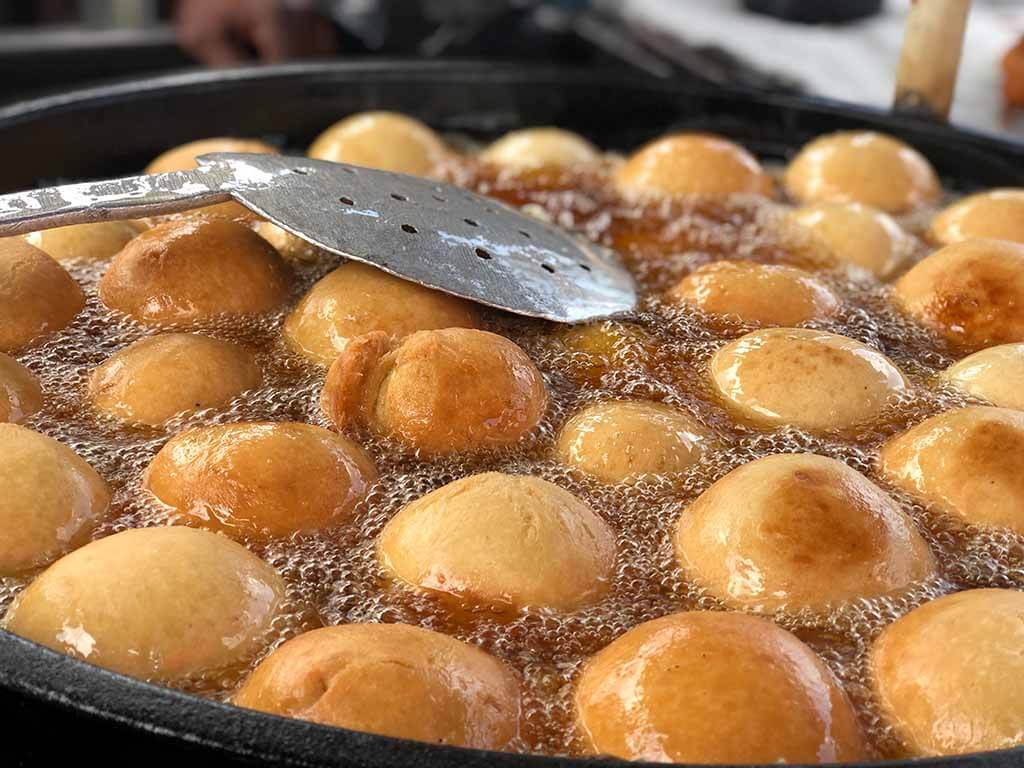
Pic by Sanne from Spend Life Traveling
One of the things I love when traveling is trying local street food. And thankfully you can find great street food in most African countries.
Puff-puff, as it is called in Nigeria, Sierra Leone and Cameroon, is a traditional, sweet African snack.
It’s made of flour, yeast, sugar, salt, water and eggs (which are optional), and deep fried in vegetable oil to a golden brown color.
And although internationally puff-puffs are best known as being Nigerian street food, you can actually find these fluffy dough balls in many West African countries, under a few different names.
In Ghana, they call them bofrot, in Ivory Coast they call them bofloto, in Congo it’s mikate, in Sudan it’s ligemat and in Liberia it’s kala. And you can find them in some other West African countries under the name manduzi.
Puff-puffs are very popular and can be eaten almost any time of day. They are often eaten for breakfast, but also as a snack, as a side dish or even as a dessert.
A puff-puff tastes a bit like a donut, but different. If you visit these parts of Africa you’ll just have to try for yourself!
The East Indians of Mumbai have something similar called foogias.
Oh and for anyone who has been to the Netherlands and tried a traditional Dutch Oliebol, yes, a puff-puff is very similar to that. Which might say something about its history but unfortunately not much is actually known about that.
By Sanne from Spend Life Traveling
Catch up with Spend Life Traveling on Facebook here!
8. Matapa in Mozambique
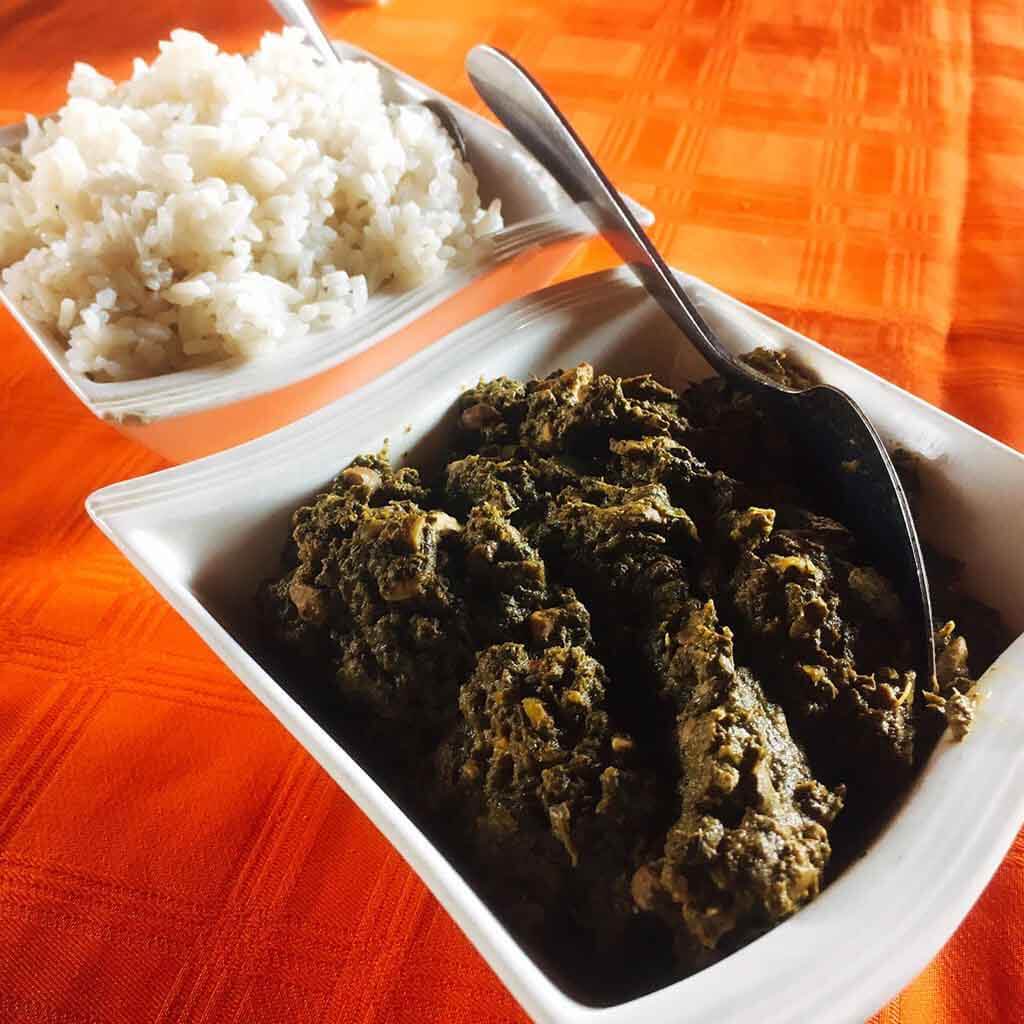
Pic by Wendy from The Nomadic Vegan
Made from nutritious ground cassava leaves, matapa is as healthy as it is delicious. After being ground by hand in a mortar and pestle, the leaves are cooked together with onions, garlic and coconut milk. Cashews are often added as well, as these nuts grow abundantly in Mozambique and therefore cost much less than in other countries.
While matapa is one of the most popular traditional Mozambican foods in homes across the country, it’s not that common in the touristy restaurants, as these mostly serve seafood dishes. To taste this authentic local dish, head to one of the hole-in-the-wall restaurants where the locals eat. Or better yet, try to get invited into a Mozambican home for dinner!
And if you’re visiting Mozambique Island, you must try the local variation of matapa there. Called matapa de siri-siri, in this version the cassava leaves are replaced by a type of seaweed called siri-siri that grows along the island’s coast. This brings a whole new meaning to the term “Mozambican seafood” and is a type of seafood that even vegetarians and vegans can enjoy! Matapa is typically eaten accompanied by a starchy food such as rice or xima (maize flour porridge).
By Wendy from The Nomadic Vegan
Catch up with The Nomadic Vegan on Facebook here!
9. Maboké in the Republic of the Congo
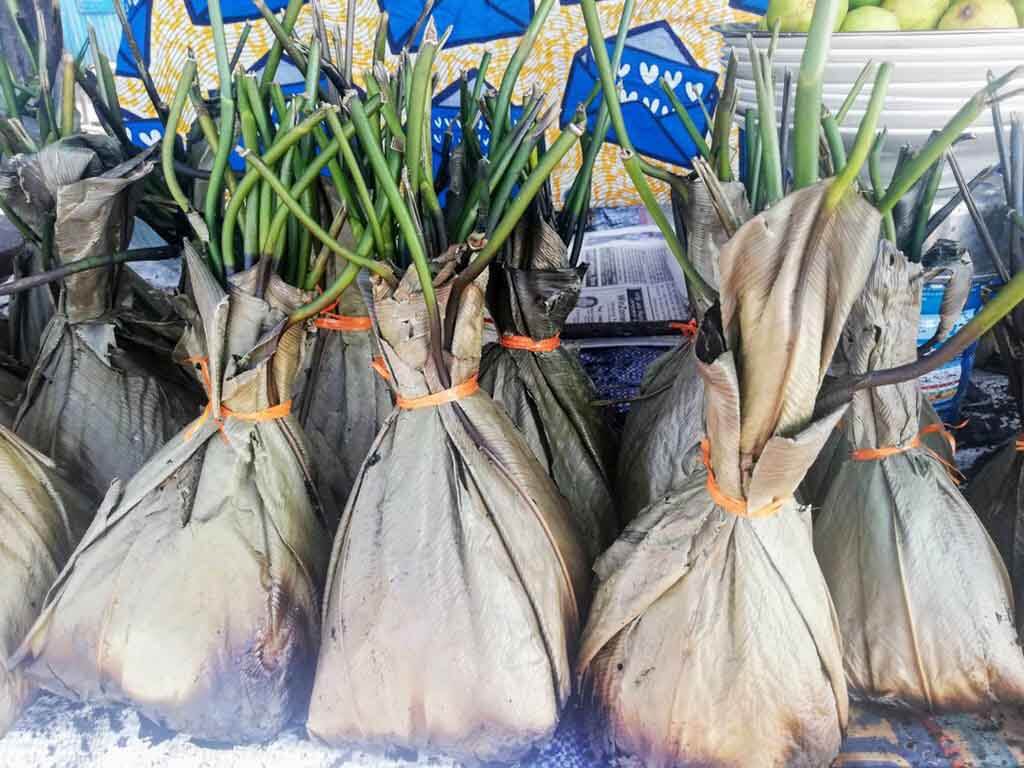
Pic by Wendy from The Nomadic Vegan
Maboké is a popular street food in the Republic of the Congo sold at roadside stalls. As it’s commonly eaten on picnics, you’ll most often see maboké stalls on roads leading to popular leisure spots, such as the confluence of the Congo River and the Djoué River on the outskirts of Brazzaville. Since the word itself means “package”, maboké can be any kind of marinated food cooked inside a banana leaf over a charcoal grill. The most common version of maboké is maboké ya mbisi, which is made with fish, but there are also meat and even vegetable versions available, which is good news for vegetarians and vegans in the Congo.
The fish, meat or vegetables are marinated in a mix of garlic, onion, ginger and other spices before being wrapped up inside the banana leaves. These leaves serve not only as the cooking utensil but also as the plate! Which is part of the reason maboké makes such a convenient picnic food. Although nowadays you’ll sometimes see more modern versions wrapped in aluminum foil. Traditionalists, however, maintain that the banana leaves are an essential component of the dish. Even though they remain uneaten, they impart a unique smoky flavor to the food as they are cooked over the charcoal barbeque.
By Wendy from The Nomadic Vegan
Catch up with The Nomadic Vegan on Twitter here!
10. Pilau in Tanzania
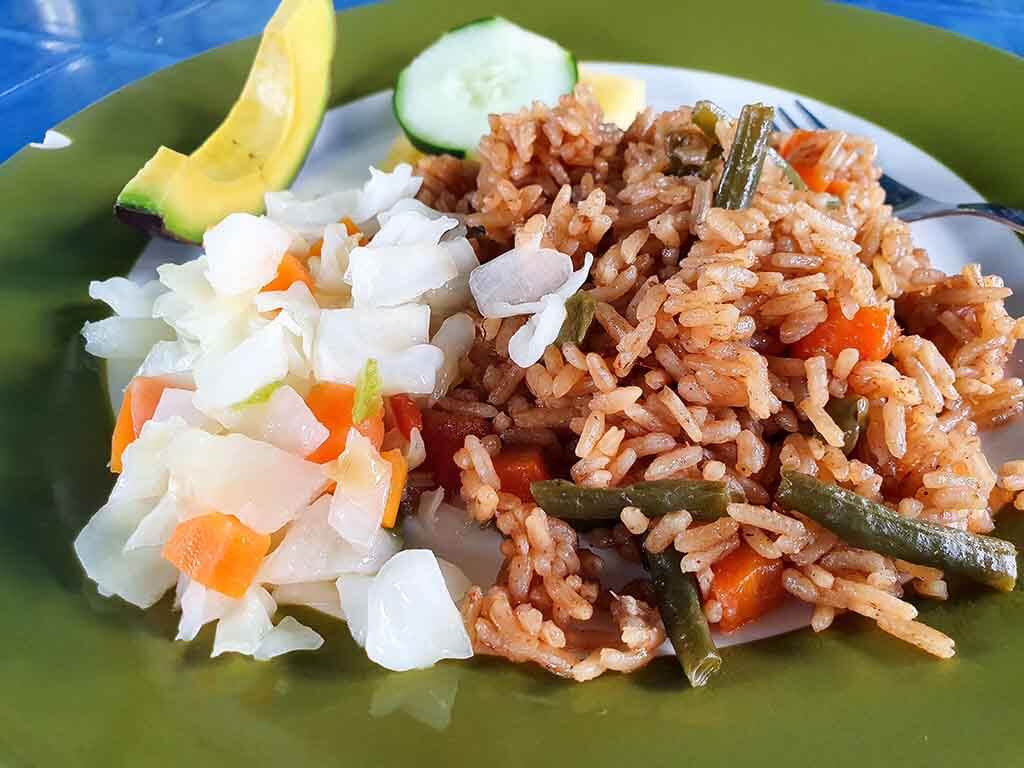
Pic by Joanna from The World In My Pocket
Pilau is a staple dish of the Tanzanian cuisine. Having its roots in the Indian cuisine, pilau has been adapted to the east African gastronomy and it is now one of the most popular dishes in the Swahili speaking countries. Each country has its own variation of pilau, with different spices and ingredients that accompany the base element, which is rice.
The Tanzanian pilau is a very aromatic dish prepared in big pots, over open fires. It is usually a celebratory dish that doesn’t miss at weddings, anniversaries or parties. Tanzanian pilau is a dish full of flavour, made with five distinct spices: black peppercorns, cloves, cardamom, cumin and cinnamon. Firstly, the onions are fried until golden, then covered with water. The spices are crushed in a mortar and added to the water, which is let to infuse for about half an hour. Then, the rice is added, after it’s been washed very well.
Pilau is not a main dish, so in Tanzania, there is no meat added directly to the rice. Pilau accompanies other dishes, such as banana stews or grilled meat.
By Joanna from The World In My Pocket
Catch up with The World In My Pocket on Facebook here!
11. Moin Moin, Nigeria
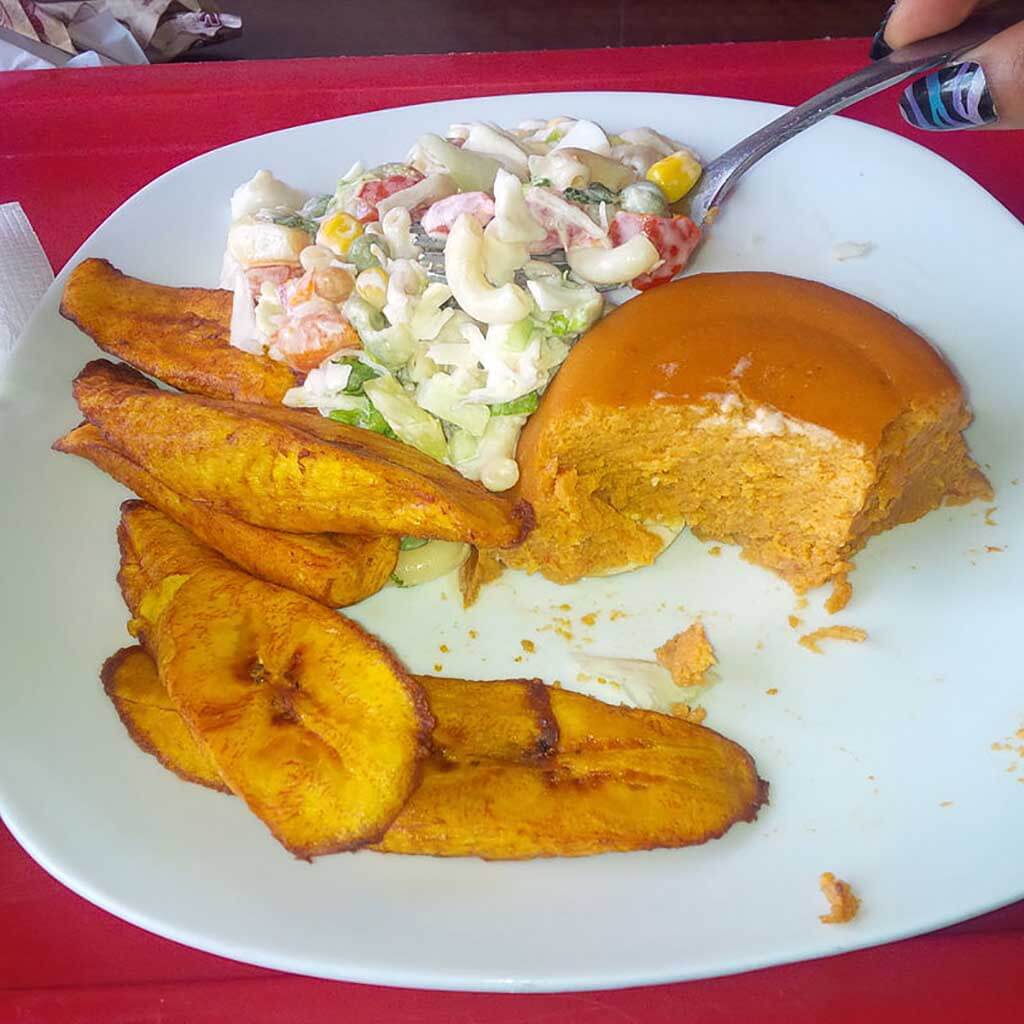
Pic by Nancy Nwachukwu from Wiki CC by SA 4.0
When speaking of street food in Africa, one simply can’t go without mentioning Moin Moin. I know that the combination of onions, black-eyed peas, and fresh ground peppers put into a pudding might not sound very appetizing, but there’s a good reason why this steamed bean pudding is one of the favorite local snacks in Nigeria.
This dish originates from Western Nigeria but you can find several different variations in different parts of the country. That’s why in some places, you might see people adding corned beef, sardines, or boiled eggs to the ingredients but the Moin Moin you get at most street food stalls in Nigeria is 100% vegan (no meat, no fish, or any other animal-derived products).
Depending on the preparation method, the final product can have a pyramid shape (when banana leaves shaped in a cone are used to shape the pudding) or cylindrical shape (when the pudding is shaped by using empty tomato cans). Moin Moin is a rich source of proteins and can be eaten with just about anything. You can serve it as a side of white rice or Garri in a proper meal, eat it straight-up as a snack, and I’ve even seen people putting the pudding inside a sandwich.
By Daniel from The Food Hog
Catch up with The Food Hog on Twitter here!
12. Kifto in Ethiopia
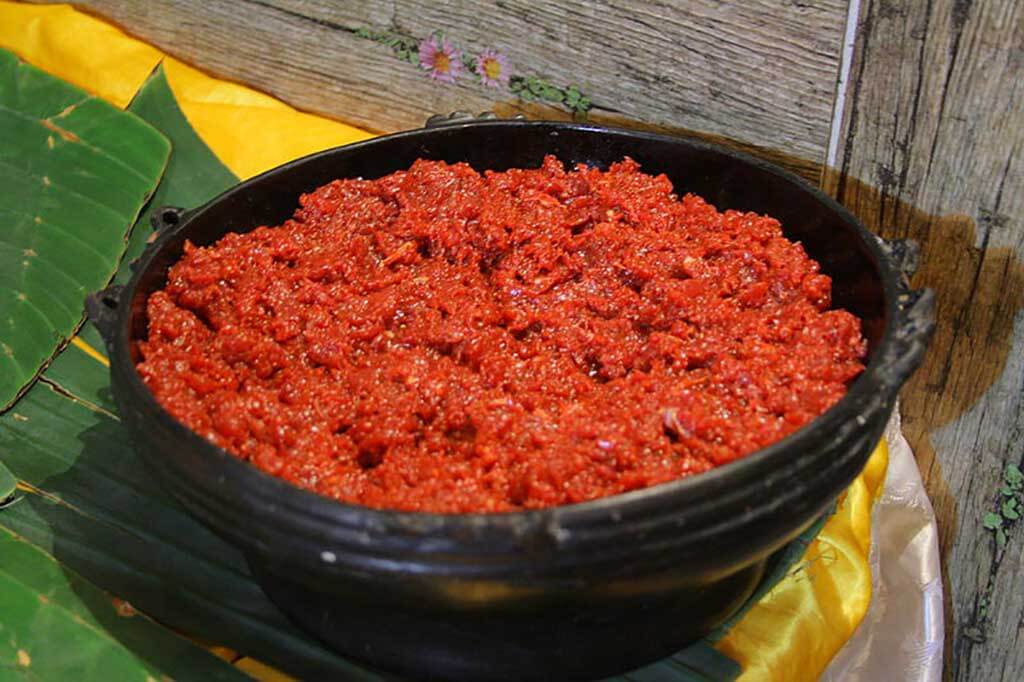
Pic by Yjohny from Wiki CC by SA 4.0
Ethiopia is the perfect place for food lovers because of the variety of food. Ethiopian cuisine is unique, which makes it one of the best African countries to visit. Kifto is a traditional Ethiopian meal that you can find all over the country, although it originated with the Gurage people in southern Ethiopia.
What is Kifto? It is minced raw beef seasoned with chile powder and topped with flavored butter. Kifto does not always have to be eaten completely raw. It’s also possible to have it cooked slightly rare.
If you want to find kifto, you can need to look for a cow or goat restaurant. You can typically find these restaurants on the side of the road with a big slab of meat hanging in the window. To order, you tell the butcher, and they cut off a chunk to prepare and usually serve it with bread, injera, and “ayib” (a white cheese). In Ethiopian fashion, Kifto is eaten with your hands. Take a piece of bread and grab some raw meat, then dip it in the cheese, and you have the perfect bite!
By Kesi from Kesi To and Fro
Catch up with Kesi To and Fro on Facebook here!
13. Bunny Chow in South Africa
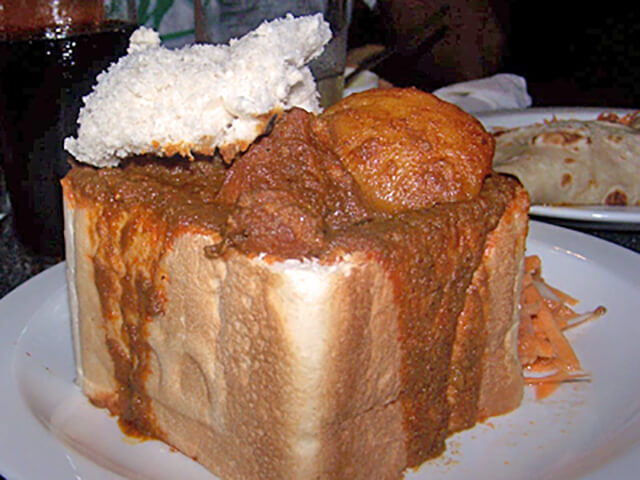
Pic by Luke Comins from Wiki CC by SA 3.0
Africa is filled with unique and weird foods that you have to try as you explore the continent. One such favourite is the bunny chow in South Africa. Originated in the Durban Indian community, this typical local meal offers a variety of ingredients and flavours piled up on one overflowing plate. Bright colours and enticing smells come standard. Bunny chow is an ideal dish to have for lunch, traditionally the largest meal of the day. Consisting of a hollowed out loaf of bread that is then filled with curry.
Different regions of the country will have variations of the same dish where commonly found ingredients include rice, beans, cooked vegetables, and a meat entree. The meat served is varied and may include beef, lamb, or chicken depending on the day. The name comes from the words “banya chow” with Banya being the old name for the Indian population in Durban while chow is the clichè for food.
The popularity of this dish is not only due to its great taste, but also as a result of its simplicity of preparation, that effortlessly brings together these items in a way to supply a complete meal for a lot of people without spending a fortune.
By Rai from A Rai Of Light
Catch up with A Rai Of Light on Facebook here!
14. Melktert in South Africa

Pic by DimiTalen from Wiki CC by SA 3.0
If you ask any local what the one food item that must be tried while visiting, the answer is more than likely to be the ever popular milk tart or locally referred to as melktert.
This South African dessert consists of a sweet pastry crust filled with a custard filling that is made from milk, flour, eggs, and sugar then baked in a round pie tin and dusted with cinnamon after baking. It is similar to a traditional Portuguese custard tart or Chinese egg tart, but with a higher ratio or milk to eggs the result is a lighter texture and a stronger milk flavour.
Fortunately, as a staple of the country’s food scene, which features an abundance of desserts, milk tart can be found in almost every town, usually at the local bakery or cafe at any time of the day. This traditional tart is also a favourite of the locals, loved by young and old alike, as their go-to after-meal dessert. Even though it may not be the most healthiest they are popular, cheap, delicious, and a must-try when in Africa.
By Rai from A Rai Of Light
Catch up with A Rai Of Light on Facebook here!
15. Beyaynetu in Ethiopia
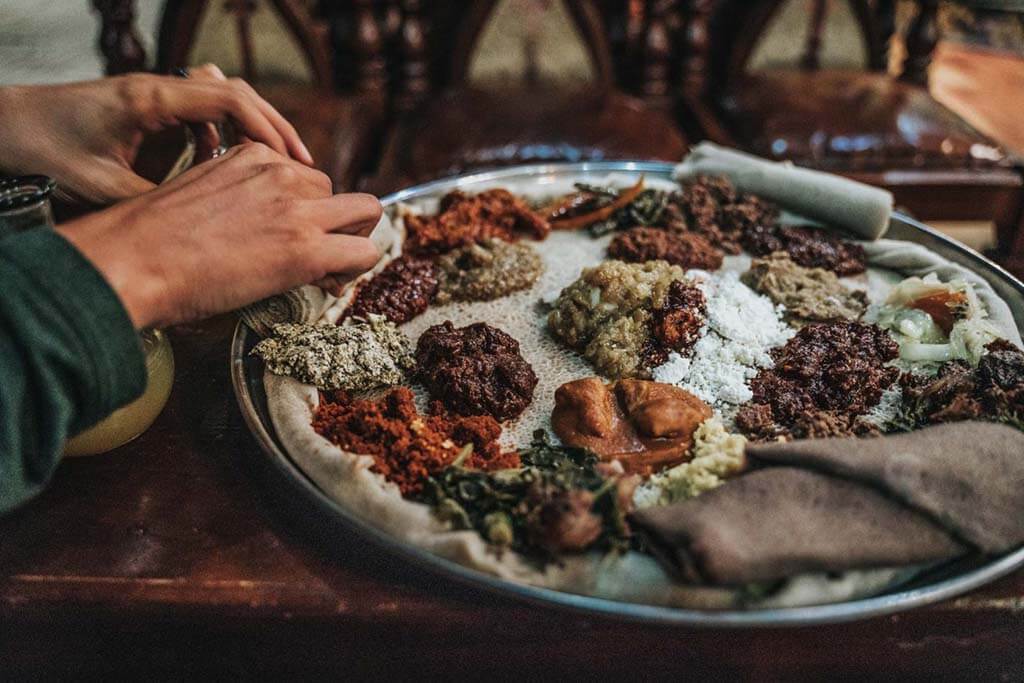
Pic by Oksana & Max from Drink Tea & Travel
If you’re looking for a little bit of everything, give the Ethiopian beyaynetu a try. It’s a combination platter made up of a mix of different kinds of watts, salads, and vegetables portioned out on a bed of injera which is a type of a crepe, made out of teff flour. It was by far our favourite dish in Ethiopia.
Watt is one of the most standard and essential Ethiopian dishes. It is a traditional stew like curry with a strong red onion base. Oil and Berbere spice is added to the softened onions to make the stew base. From there, you can choose a multitude of different ingredients and vegetables like peas, potatoes, and carrots.
Most restaurants offer beyaynetu on Wednesdays and Fridays which are fasting days for the members of the Ethiopian Orthodox Church. However, fasting in Ethiopia doesn’t mean abstaining from food. It simply means not eating meat and animal products – what we know as following a vegan diet. Therefore beyaynetu is a great option for vegetarians and vegans visiting the country!
By Oksana & Max from Drink Tea & Travel
Catch up with Drink Tea & Travel on Facebook here!
16. Chakalaka in Southern Africa
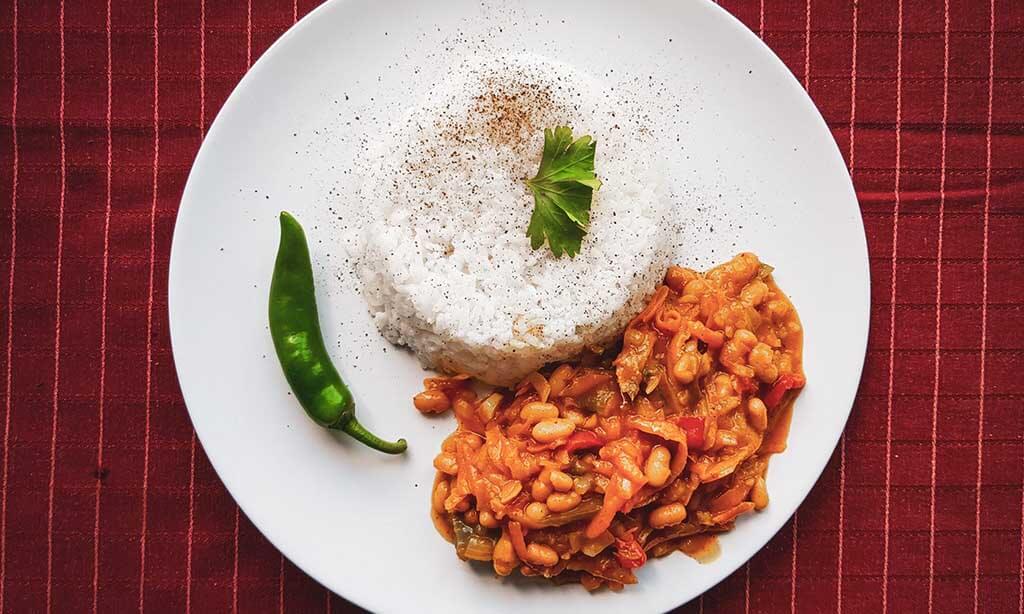
Pic by Stephanie from The Africa Cookbook
Chakalaka is a popular dish in southern Africa. It originally comes from Johannesburg, where Mozambique laborers created and popularized it. However, just like Jollof rice has become part of the culture in many western African countries, Chakalaka is an important dish across the countries of Southern Africa. My favorite version of Chakalaka is from Bulawayo, Zimbabwe.
Chakalaka is a spicy bean salad. You make it by combining baked beans, peppers, cabbage, carrots, and spices over a stovetop and letting the flavors meld into each other.
You can use a pre-made Chakalaka spice blend, or you flavor it with individual spices. You’ll need curry, ginger, and paprika to get it just right, in addition to fresh garlic.
Serve Chakalaka with rice or pap, a corn porridge. You can eat Chakalaka as a main dish or as a side dish. It just depends on how hungry you are!
You can eat it after you make it, but it’s one of those dishes that gets even tastier when you eat it the next day. This makes it a great dish to cook over the weekend and eat for lunches or dinners throughout the week!
By Stephanie from The Africa Cookbook
Catch up with The Africa Cookbook on Facebook here!
17. Sadza with kovo vegetable curry from Zimbabwe
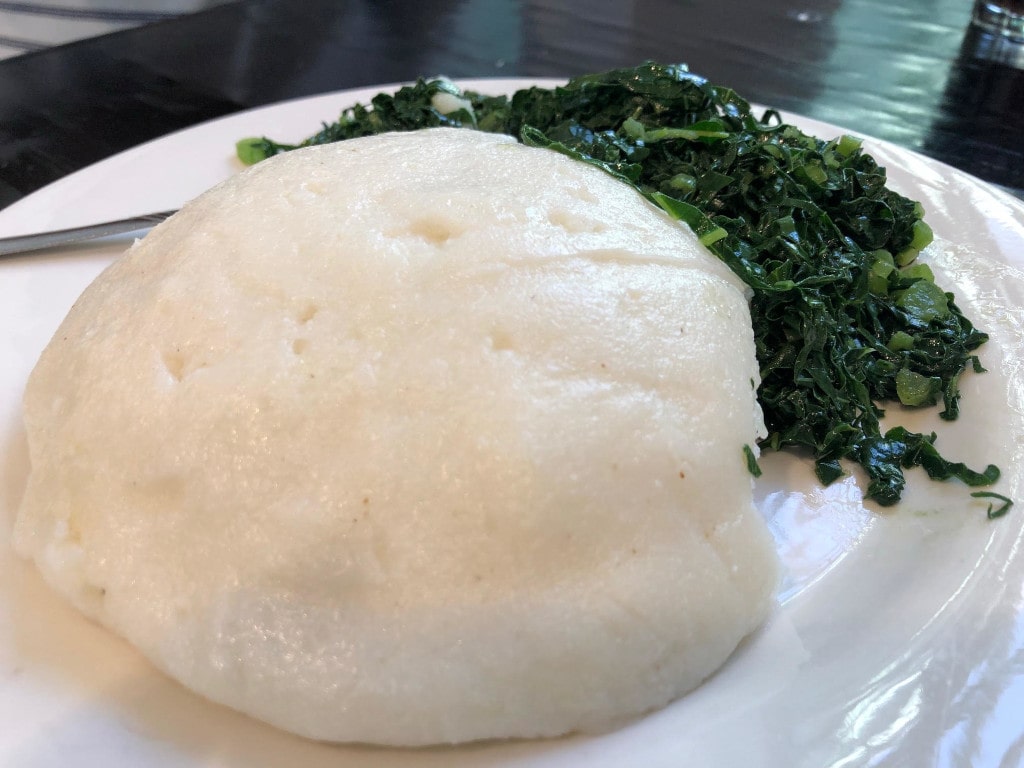
Pic by Jyoti from Story At Every Corner
In simple terms, Sadza is essentially a ball of corn flour, water and salt, very much like the Kenyan ugali which goes with various names in many countries in Africa. Sadza is deliciously soft and served with kovo, a vegetable curry. The traditional curry is made from dark green leafy vegetables which itself is flavorful. In nicer restaurants sadza is served more fancy mixed vegetables with curry spices.
If you’re traveling to Zimbabwe, be sure to try sadza and vegetable curry in Victoria Falls in Mama Africa. Check out more details in this 14-Day itinerary of Southern Africa.
Traditionally, sadza is made from white corn but many a times is also made from the yellow corn imported from Kenya. Sadza is a local, inexpensive, nutritious and delicious meal. Traditionally the meal is vegan but with prosperity, game meat curries are more popular among tourists. You’ll find all the variations and many more traditional dishes in Victoria Falls, you only need to ask a local.
By Jyoti from Story At Every Corner
Catch up with Jyoti at Story At Every Corner on Facebook!
18. Potjiekos in South Africa
Sometimes, the best local meals are the ones which aren’t that easy to find in restaurants. South African potjiekos is a good example of this. An Afrikaans dish, directly translating to “small pot food”, potjiekos is essentially a stew, which is slowly cooked in a cast-iron pot, directly over the coals. Meat, vegetables and potatoes are layered in the pot, usually with a small amount of beer and wine and seasoned with Dutch-Malay spices, and slow-cooked for 2-3 hours. The major difference between potjiekos and stew, is that you don’t stir the potjie.
Making potjiekos is a communal affair, with people talking and drinking in front of the fire for hours. In Cape Town especially, potjiekos is often part of a braai or South African barbeque, which may include other meats and salads (Cape Townians are renowned for making too much food). When the potjiekos is ready, the meat and vegetables are spooned onto plates and sometimes served with rice or pap, a maize-based porridge.
By Roxanne from Faraway Worlds
Follow Roxanne on Facebook at Faraway Worlds
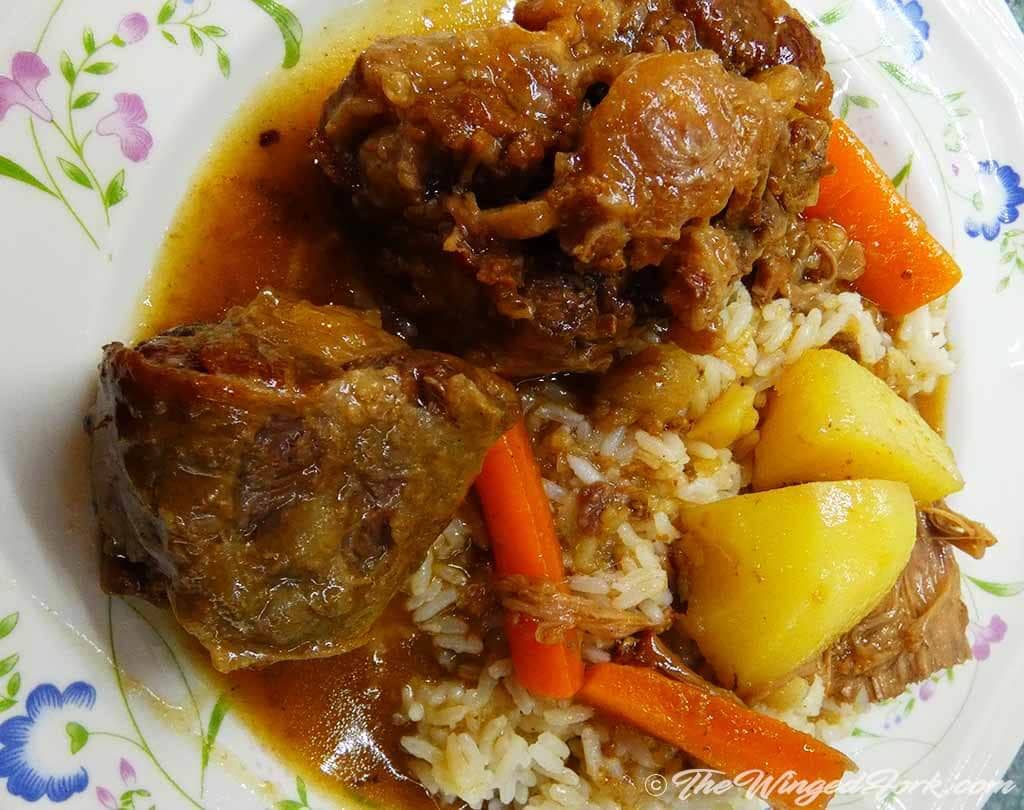
Try my sis-in-law’s recipe if you want to make an oxtail potjiekos at home!
19. Bobotie in South Africa
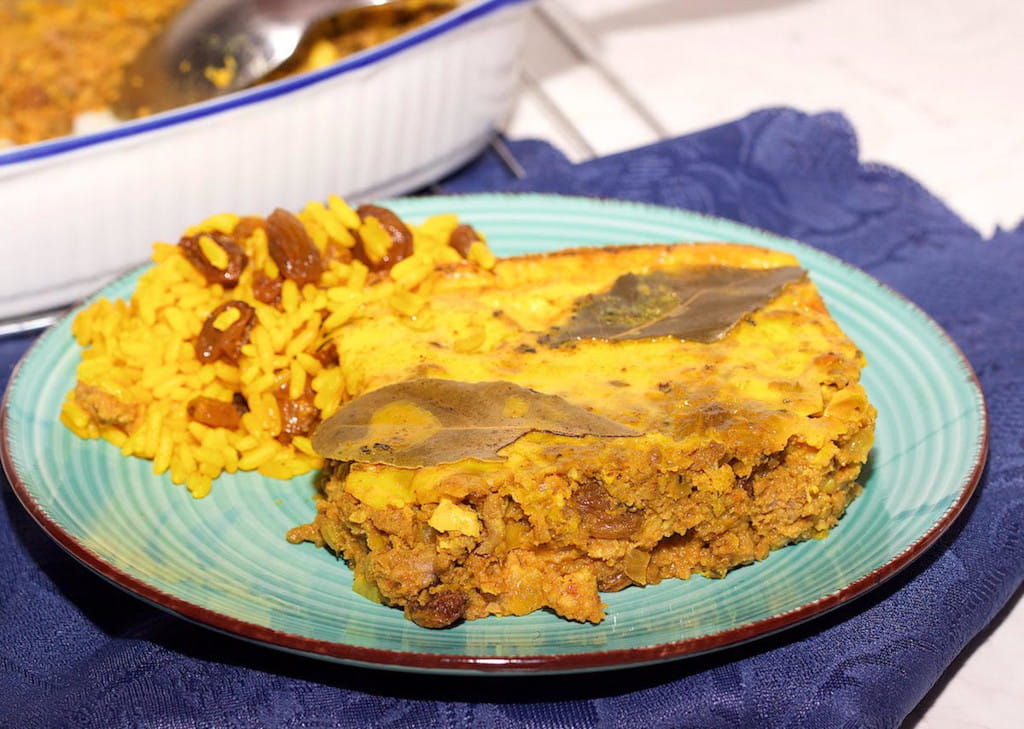
Pic by Sabine of The Tasty Chilli
Bobotie is often considered to be the national dish of South Africa. This curry dish is a fusion of Asian, African and European cuisine.
There are different versions of the origin of bobotie. One version is that it was introduced in South Africa in the 17th century by the Malay people who were brought to the Cape province and more specifically Cape Town, to work as slaves.
The Malay people introduced it into the Dutch households, who were ruling the Cape province at that time and adjusted it to their palette. Nowadays it is considered a Cape Malay dish, named after the Malaysian people who have since then permanently settled in the colourful neighbourhood, Bo-Kaap in Cape Town.
South African bobotie is a mild and rather sweet minced curry topped with an egg custard. Over the years it got introduced into the rest of the country and it became a very popular dish with tourists visiting South Africa. Traditionally it is eaten with fragrant yellow rice and various sambals to spice it up.
By Sabine from The Tasty Chilli
Follow Sabine on Facebook at The Tasty Chilli
20. Jollof Rice in Nigeria
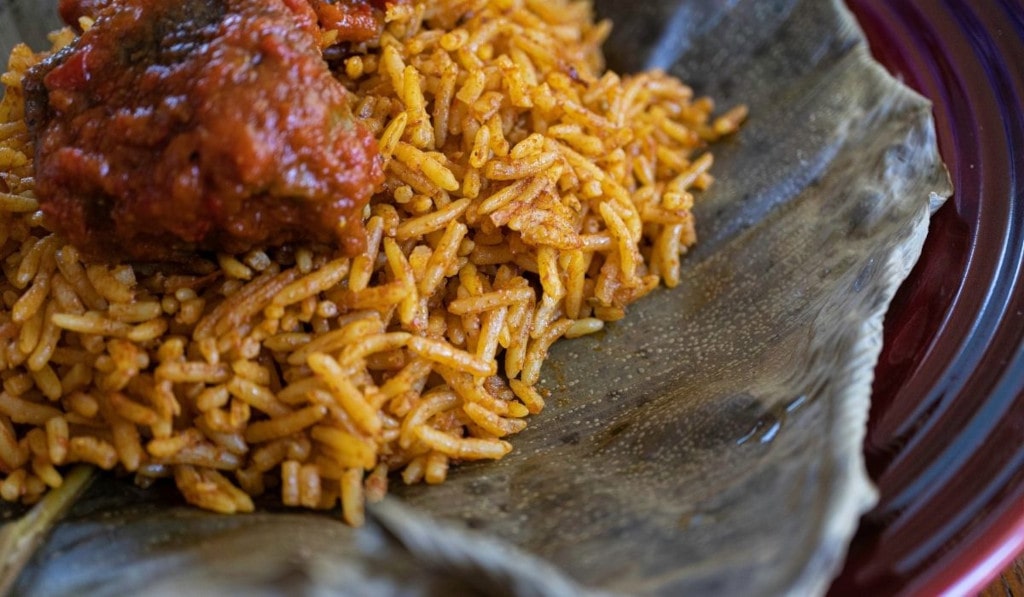
Pic by Fay of Cape to Casa
Jollof Rice is a dish unique to all of West Africa but plays an important role in Nigerian cuisine. Nigerian Jollof Rice is special due to its spices. It is made with a mixture of local spices such as white pepper, black pepper, Nigerian curry powder, and dried thyme.
However, the secret to the amazing taste of the Nigerian version comes from the creamy tomato sauce which is made from a mixture of fresh tomatoes, red onions, and Nigerian Red peppers. Once your tomato mix is well cooked it is time to add the rice.
Jollof rice is best enjoyed using long grain Basmati Rice which really soaks up that lovely hot tomato flavor. After cooking the rice in the tomato sauce for 30 minutes, get ready to taste an amazing red spiced rice that is probably going to be your new favorite.
Nigerian Jollof Rice can be served up with meat or chicken but, to be honest, you can even have it on its own. It’s really that good.
By Fay from Cape To Casa
Follow Fay on Facebook at Cape to Casa
From the continent that may very well have been the center or creation and the first place food was cooked, these dishes can definitely get the tummy rumbling for more. What’s your favorite African meal? Is it on this list?
If you’re favorite African food is not on this list, email me at abby@thewingedfork.com with a pic of it along with a brief history, and we might just add it in.
Other Foodie Posts & Listicles For Your Reading Pleasure
- Mexico City’s most popular hotspots
- Over 50 Best Street Food In Europe
- Christmas Dishes and Sweets from across the globe
- What to eat in Switzerland
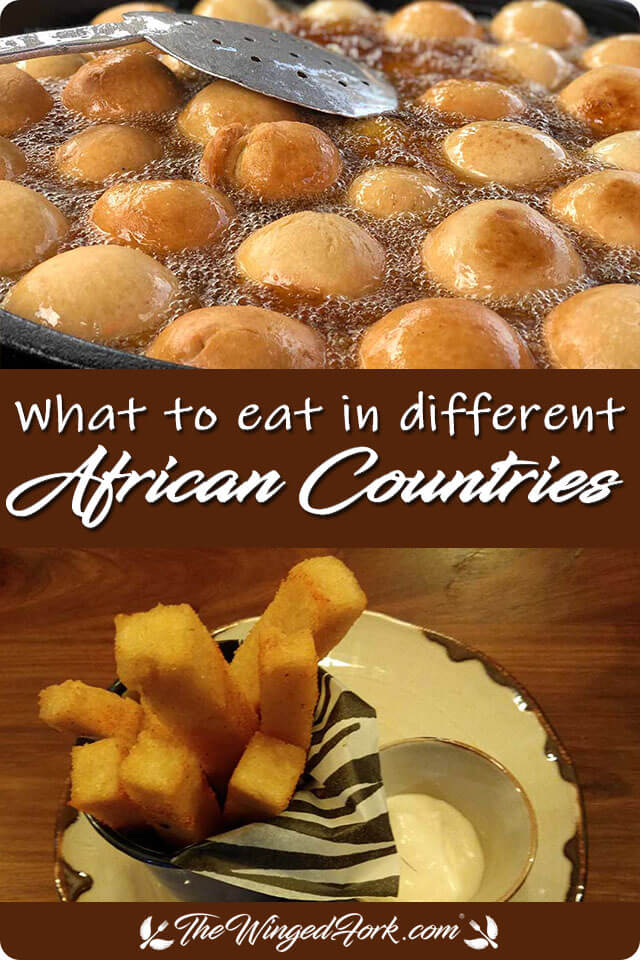
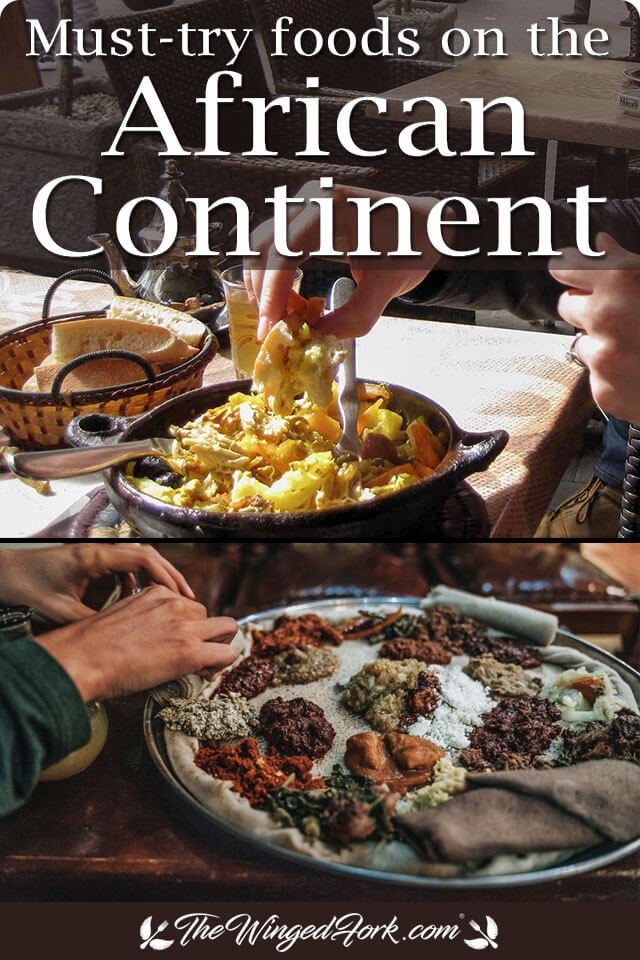
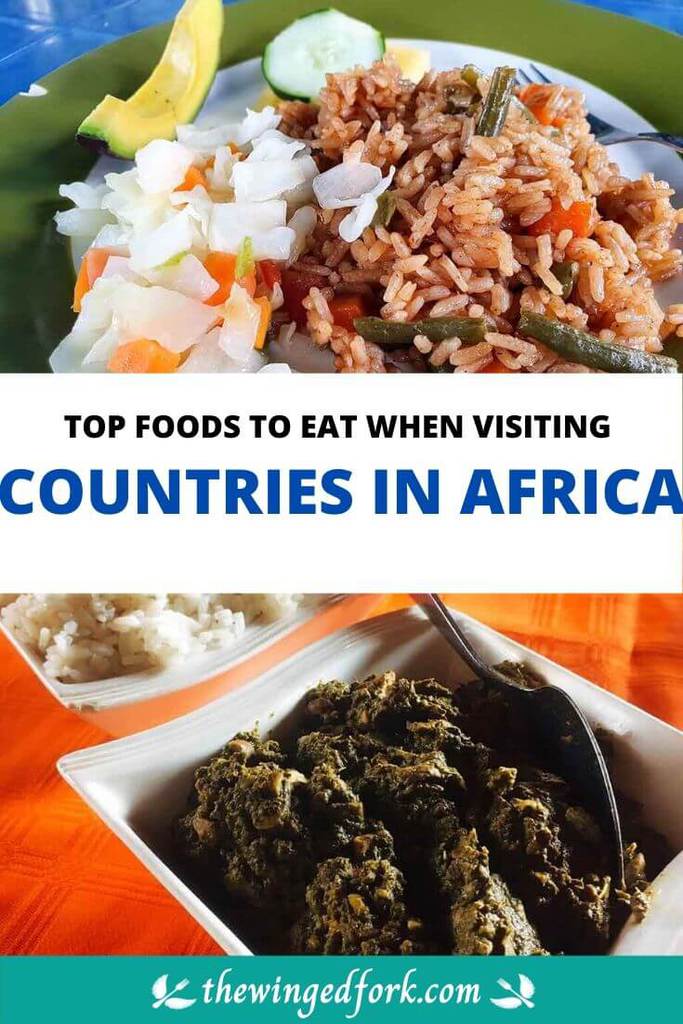

I’m an East Indian foodie and travel blogger from Bombay, India. I’ve travelled across parts of Europe and Asia, and love writing about my experiences with people and cultures. And naturally, I love food, wine, and travel, and have an endless bucket list of places to go to, and experiences I must blog about.
I also love baking and experimenting with food, with a little help from my family. If you must know, my favorite things are nice rainy days, the smell of cakes in the oven, playing in the snow, glasses of wine, and dark chocolate.
More info about me here!
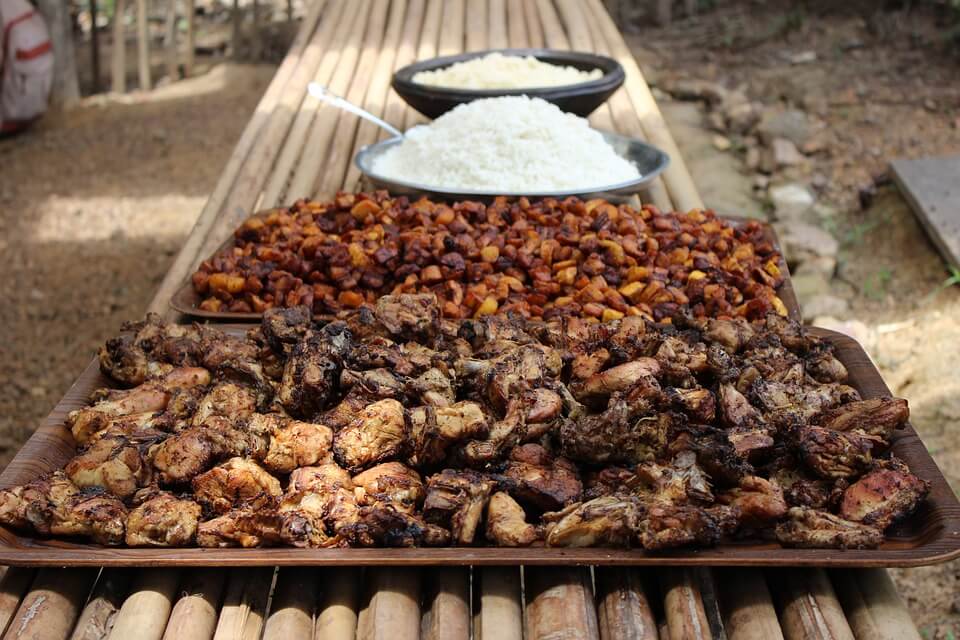
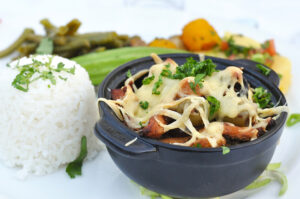
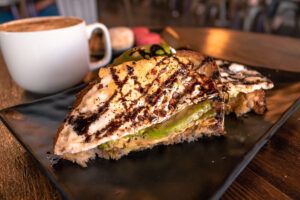

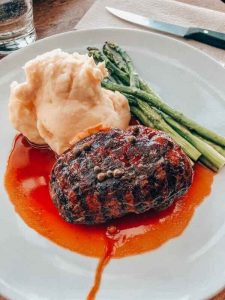

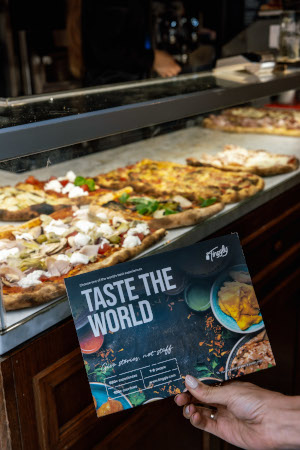
Thanks for sharing! I’m hungry now…
Cheers,
Dariece